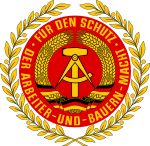|
National Defence Council (East Germany)
The National Defense Council of the German Democratic Republic (German: Nationaler Verteidigungsrat der DDR - NVR) was created in 1960 as the supreme state body of the German Democratic Republic (also known as East Germany or the GDR) in charge of national defense matters, including mobilization planning. The NVR held the supreme command of the GDR's armed forces (including the internal security forces), and the NVR's chairman was considered the GDR's commander-in-chief.[1] BackgroundThe predecessor of the NVR, the Security Commission of the Politbüro of the Central Committee of the Socialist Unity Party of Germany (SED), met for the first time on 6 July 1954. With the enactment of the "Law on the Formation of the National Defense Council of the GDR" on 13 February 1960, the Security Commission was transformed into the NVR.[2] When the State Council was created on 12 September 1960 to replace the office of President, the law creating the State Council (which amended the 1949 GDR Constitution) also acknowledged the role of the NVR in GDR defense policy.[3] On 9 April 1968, when the 1968 GDR Constitution became effective, the NVR was designated as the supreme leadership body of the state in time of war or national emergency, with full legislative and executive authority. The first session of the NVR convened on 16 March 1960; the 78th, and last, session convened on 16 June 1989. Composition of the NVRThe NVR consisted of a chairman and at least 12 members, all of whom were members of the CC of the SED; most were also members of the CC's Politbüro. Some of the members of the NVR also held leadership roles in the "armed organs" (bewaffnete Organe) of the state: the National People's Army, the Volkspolizei, and the Ministry of State Security. Subordinate to the NVR were the regional (Bezirk) and district (Kreis) operational directorates (Einsatzleitungen), whose chairmen were also the first secretaries of the regional and district party organizations of the SED. Leadership of the NVRThe NVR strengthened Walter Ulbricht's claim as the leading political force in the SED, as he became the NVR's first chairman, even though Wilhelm Pieck was still president of the GDR at the time. Upon Erich Honecker's rise to power in 1971, he replaced Ulbricht as chairman of the NVR. Egon Krenz became chairman of the NVR on 24 October 1989 following Honecker's resignation as state and party leader, but held on to power himself for only a few weeks in the wake of the Die Wende and the fall of the Berlin Wall. Judicial Consequences Following German ReunificationAfter German reunification in October 1990, individual members of the NVR were prosecuted in connection with their political responsibility for the regime's border policies, including the use of deadly force (Schießbefehl) and the deaths of escapees along the inner-German border and the Berlin Wall. As an example, in 1997, Krenz was convicted and sentenced to 6½ years in prison for his role in the deaths of four escapees, although he actually served just under four years (13 January 2000 to 18 December 2003) before being released on parole. Security Arrangements for Members of the NVRAn underground bunker was built in Prenden, near Wandlitz, for the members of the NVR; this was the largest bunker complex in the GDR. Members of the NVR (Mid-1989)
See alsoNational Defense Commission of North Korea Footnotes
References |
||||||||||||||||||

























